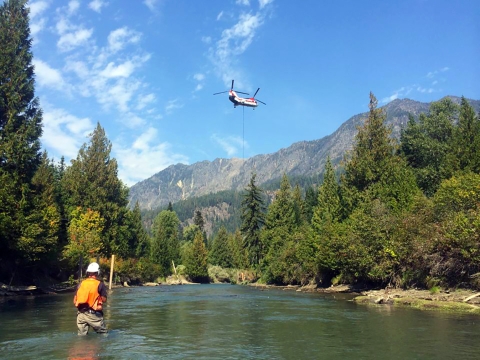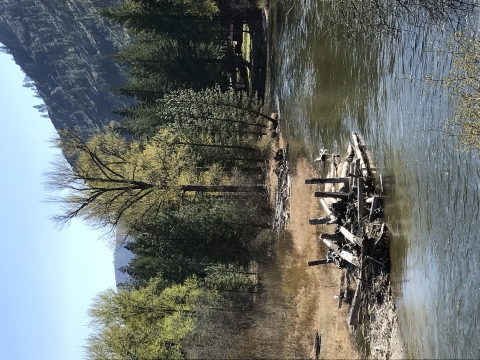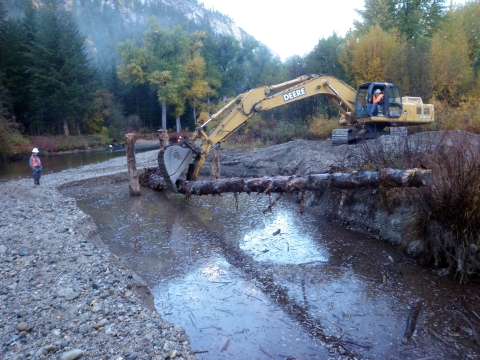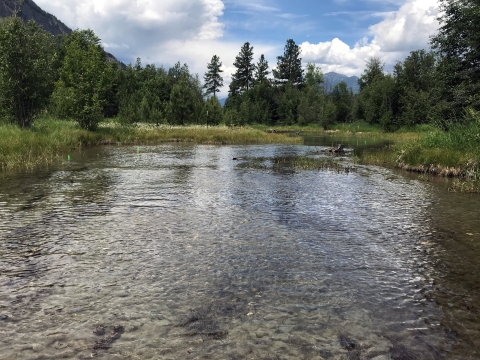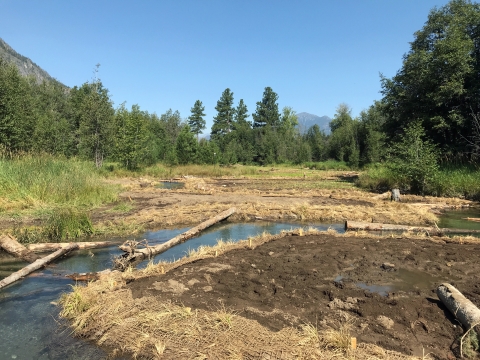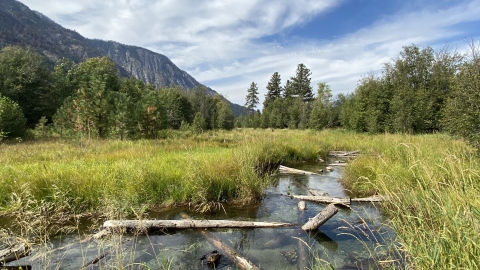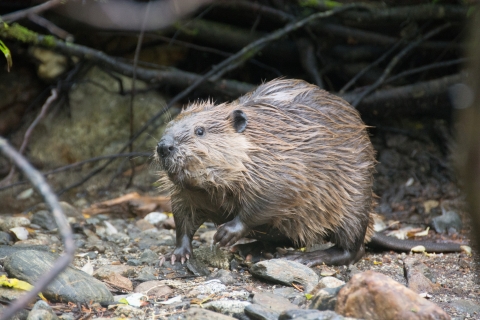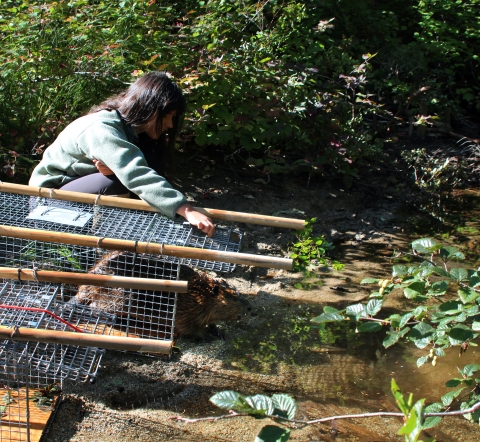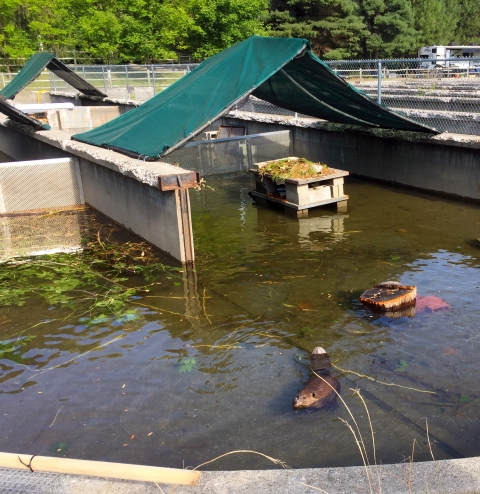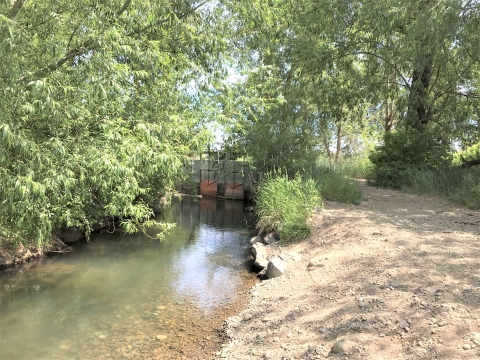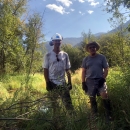States
WashingtonWe work cooperatively with our partners to enhance and restore aquatic habitats through innovative techniques and best available science for the benefit of our native species in the Mid- and Upper Columbia.
Program Overview
We partner with private landowners, non-profit organizations, and local, state, and federal agencies. We work with these partners to provide technical assistance in the form of habitat evaluation, surveying, engineering design, hydraulic analysis, contracting, project implementation, and monitoring. Additionally, we administer the USFWS Partners for Fish and Wildlife and the National Fish Passage Program. Funds from these programs are used for the development and implementation of restoration projects throughout Central and Eastern Washington.
Our program’s philosophy is based on a belief that healthy fish and wildlife populations create healthy communities. Our design doctrine stems from a conviction that the best engineering solutions are found in nature and the holistic restoration of natural processes is fundamental to long-term success.
Using our technical skills to leverage Service funding, we work on a variety of habitat restoration projects. We provide survey, design, and other forms of technical assistance so our ability to help is not just limited to our funding.
How to Apply for Funding
Funding for habitat restoration projects is awarded through our three main programs: the Partners for Fish and Wildlife Program, the National Fish Passage Program, and the Western Native Trout Initiative. Project types, award amounts, and eligibility vary by program. We encourage prospective partners to contact us directly prior to applying. We work with potential partners throughout the year; however, a formal request for proposals typically occurs in late fall each year, with funding made available by the following spring.
Example Projects
Instream Habitat Enhancement: Dillwater engineered log jams
Planned and constructed in close partnership with the Chelan County
Natural Resources Department, this project was constructed in 2014 to enhance rearing habitat for steelhead, spring Chinook, and bull trout. We completed all the hydrologic analysis, engineering design, and construction oversight. Five large engineered log jams (ELJs) were built using design methods derived from our research into persistent, naturally-stable wood accumulations. This work, along with other subsequent projects, has shown that ELJs which emulate specific geomorphic and structural elements can be stable at very high flows without the use of artificial anchoring or large rock. We pride ourselves in being able to deliver technical services from concept through design, construction, and monitoring.
Stream Channel Reconstruction: Hancock Springs restoration
Hancock Springs is a unique, true spring-fed stream in the upper Methow River watershed. After it was initially cleared by homesteaders, it was a dairy operation for many decades. Excessive livestock use trampled the streambanks and removed much of the riparian riparian
Definition of riparian habitat or riparian areas.
Learn more about riparian vegetation, resulting in the loss of the original channel form.
Starting in 2008 with our numerous partners, including the Yakama Nation, Methow Conservancy, and Cascade Fisheries, we worked to restore the system for the benefit of salmon, steelhead, bull trout, and other wildlife. We completed all topographic surveys, hydrology measurements, and engineering design for the two primary phases of work (2011 and 2019). In addition, we completed many aspects of permitting, contracting, and monitoring. We were on-site for each day of construction to help build a narrow, sinuous channel with deep pools, riffles, alcoves, and off-channel wetlands. The resulting product is one of the most diverse, productive areas in the Methow Basin and showcases the complete turnkey services our group can provide.
Beaver-Influenced Restoration: Wenatchee Beaver Project
The Leavenworth Fisheries Complex has worked with Trout Unlimited since 2017 to implement the Wenatchee Beaver Project. We helped secure initial funding and have provided technical assistance and facility space each year since. The program offers a service to landowners who have nuisance beavers on their property.
While every effort is made to allow coexistence, sometimes land uses are incompatible with beaver activity. When this occurs, beavers are trapped and brought to the Leavenworth National Fish Hatchery for weighing, sexing, and acclimation. If possible, the entire family group is reunited, or suitable pairs are matched, for later release.
The beavers are transported to pre-scouted, higher elevation sites on the nearby Wenatchee National Forest, where they are released. Beavers have tremendous ecological benefits, including water storage, wildfire remediation, and fish habitat improvements. Instead of being lethally removed, we have worked with our partners to allow these ecosystem benefits to occur and allow landowners to maintain economic vitality from their property.
Riparian Revegetation: Upper Yakima River riparian forest restoration
The Upper Yakima Riparian Forest Restoration project addresses water quality impairments on the Yakima River through restoration and protection of riparian forests in Kittitas County. The project aims to increase shade to the stream and reduce bank erosion, as well as improve riparian forest condition and improve planting success through weed control and irrigation now that the property is no longer being grazed by cattle.
The project will improve riparian forest condition of 32 acres and 2,700 feet of streambank at Yakima River mile 160. Work at this site will include restoring 8.3 acres of riparian vegetation along a 1500 ft length of the Yakima River and 1200 ft side channel, rehabilitating a 1.6 acre floodplain grassland, and installing temporary elk exclusion fencing around the planting plots.
In 2020, planting plots were mapped, mowed, and noxious weeds were controlled. In 2021, the restoration team finished installing black landscape fabric to reduce the noxious weed population within the planting plots.
The Mid-Columbia Fisheries Enhancement Group hosted a volunteer planting party to install most of the new vegetation. Irrigation lines and fencing were completed in the fall. After 3 to 4 years, plants will be above the browse height of deer and elk. At that point, the exclusion fences will be removed. Fencing is necessary to ensure plant survival.
Fish Passage Improvements: Bull Canal Side culvert replacement
Bull Canal is an artificial side channel on the left bank of the Yakima River which provides water conveyance to a point of diversion downstream for a large irrigation company. The side channel is unique in providing low-gradient, cool-water rearing habitat for threatened and endangered fish in the mid-Yakima mainstem. The inlet headgate, associated weir, and limited slope in the side channel were poorly functioning, and the channel dewatered for a portion of the year, stranding fish.
USFWS partnered with Mid-Columbia Fisheries and the City of Ellensburg to replace the headgates and culverts with a bridge to allow the river to flow naturally into the side channel, allowing high flows to scour the side channel and improving year-round flows for juvenile fish. Construction occurred in September of 2021.
Screening and Diversion Improvements: Swauk Creek diversion consolidation
The Service partnered with Kittitas County Conservation District to implement the Swauk Creek Diversion Consolidation Project. This fish passage fish passage
Fish passage is the ability of fish or other aquatic species to move freely throughout their life to find food, reproduce, and complete their natural migration cycles. Millions of barriers to fish passage across the country are fragmenting habitat and leading to species declines. The U.S. Fish and Wildlife Service's National Fish Passage Program is working to reconnect watersheds to benefit both wildlife and people.
Learn more about fish passage project consolidated two gravity irrigation diversions into a single existing point of diversion and installed a fish screen to return fish to Swauk Creek. Prior to this project's implementation, ESA threatened steelhead had a high rate of stranding in the irrigation ditches.
At the consolidated point of diversion, a roughened channel fishway was constructed to facilitate year-round fish passage for native salmonids. In addition, the irrigation conveyance ditch was piped to accommodate the change in point of diversion and to reduce evaporation and infiltration, resulting in conserved water available for instream flow benefit. Lastly, a robust planting of cottonwood trees in strategic locations were installed to provide shade and future woody debris for the stream and floodplain. Construction occurred in September 2021.
Dam Removal: Nelson Dam removal
Dam is an eight foot-high, river-spanning structure structure
Something temporarily or permanently constructed, built, or placed; and constructed of natural or manufactured parts including, but not limited to, a building, shed, cabin, porch, bridge, walkway, stair steps, sign, landing, platform, dock, rack, fence, telecommunication device, antennae, fish cleaning table, satellite dish/mount, or well head.
Learn more about structure on the Naches River, the largest tributary to the Yakima River. Built in the 1920s to divert irrigation water for the City of Yakima and the Naches-Cowiche Irrigation Company, the dam facilitated water delivery to over 8,000 users but provided no fish passage. In 1985, an unsuccessful attempt was made to provide passage.
The dam has held back large quantities of gravel, sediment, and silts, which raised the riverbed enough to cause the Naches River to overflow its banks even during small floods. This resulted in frequent damage to businesses, homes, and roads while also causing excess erosion and disconnection from the floodplain downstream.
Initiated by the Yakima Basin Integrated Plan, the City of Yakima and Yakima County collaborated on the design and implementation of a $26 million project. A multi-agency effort, major funding comes from the City, Washington State Floodplains by Design, Brian Abbott Fish Barrier Removal Board, Community Capital Facility Funds, and the Bureau of Reclamation. The Service provided partial funding for the design of the Nelson Dam Removal Project and provided technical assistance de-fishing the work zone before demolition of the dam began in 2021.
The dam will be replaced with a roughened channel, allowing the river to flow naturally while still providing water to the new irrigation diversion at all river levels. It will also provide unimpeded upstream and downstream fish passage for all species (such as bull trout, steelhead, Chinook and coho salmon, and lamprey) and life stages (juvenile and adult). Removal of the dam will allow sediment transport and floodwater conveyance, which will significantly ameliorate flooding and downcutting issues.
The new irrigation diversion provides more effective and easier-to-maintain fish screening, improves water supply reliability, and removes open channel conveyance, and will save four acre-feet of water lost each year to evaporation. Construction of the roughened channel and new irrigation diversion infrastructure also allows for removal of two downstream diversions and associated levees. Dam removal and construction of the roughened channel are schedule for completion in 2022, and the new irrigation diversion is expect to be completed by 2024.

